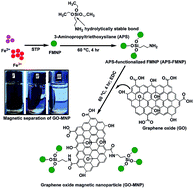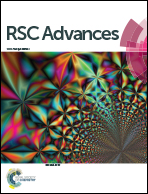Synthesis of covalently bonded graphene oxide–iron magnetic nanoparticles and the kinetics of mercury removal†
Abstract
Synergistically combined nanomaterials have been applied in various fields in materials science to improve the properties of nanocomposites. However, limited studies focus on the ability of such composites for water treatment. A graphene oxide (GO)–iron oxide (Fe3O4) magnetic nano-particle composite (GOMNP) was synthesized and used to study the Hg2+ adsorption kinetics from aqueous solution at various temperatures. GO was attached to magnetic nanoparticles via the amine group of 3-aminopropyltriethoxysilane which was attached the surface of Fe3O4. The GOMNP nano-composite had a Hg2+ adsorption capacity of 16.6 mg g−1. IR spectra analysis showed that hydroxyl and carboxylate functional groups were mainly responsible for Hg2+ adsorption. Adsorption of Hg2+ by the GOMNP obeyed different adsorption mechanisms at varying adsorption temperatures. The Elovich kinetics model described the Hg2+ adsorption data better than any of the other three models tested. The GOMNP nano-composite is thus a promising nanosorbent for Hg2+ removal from aqueous solutions.


 Please wait while we load your content...
Please wait while we load your content...